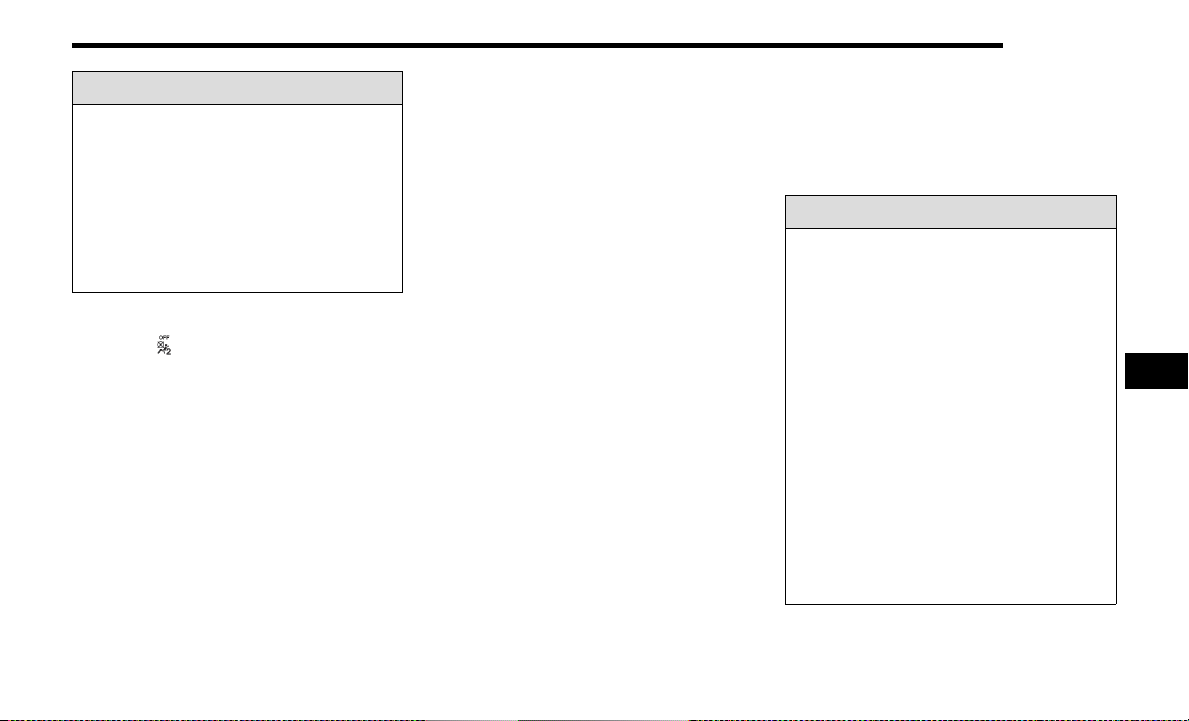Loading ...
Loading ...
Loading ...

SAFETY 271
Passenger Advanced Front Air Bag Disabled (PAD)
Indicator Light
The Passenger Advanced Front Air Bag Disabled (PAD)
Indicator Light (an amber light located on the overhead
sports bar) tells the driver and front passenger when the
Passenger Advanced Front Air Bag is deactivated. The PAD
Indicator light illuminates the words “PASSENGER AIR BAG
OFF” to show that the Passenger Advanced Front Air Bag
will not deploy during a collision. When the front
passenger seat is empty or when very light objects are
placed on the seat and the seat belt is unbuckled, the
Passenger Advanced Front Air Bag will not deploy even
though the PAD indicator light is NOT illuminated.
The PAD indicator light should not be illuminated when an
adult passenger is properly seated in the front passenger
seat. The driver and adult passenger should verify that the
PAD Indicator Light is not illuminated when an adult is
riding in the front passenger seat. If an adult is not seated
properly, the Passenger Advanced Front Air Bag may
deactivate and the PAD Indicator Light will be illuminated.
The PAD Indicator Light should be illuminated and the
Passenger Advanced Front Air Bag should be deactivated
for most properly seated and restrained children in the
passenger seat and for most properly installed child
restraint systems. However, under certain conditions,
even with a properly installed child restraint system, the
PAD Indicator Light may not be illuminated, even though
the Passenger Advanced Front Air Bag is deactivated. This
can occur if the child restraint is lighter than the lightest
weight necessary to illuminate the PAD Indicator Light.
NEVER assume the Passenger Advanced Front Air Bag is
deactivated unless the PAD Indicator Light is illuminated
with the words “PASSENGER AIR BAG OFF.”
NOTE:
If the seat belt is buckled for an empty seat, the PAD Indi-
cator Light will illuminate.
If The PAD Indicator Light Is Illuminated For An Adult
Passenger:
If an adult passenger is seated in the front passenger seat
and the PAD Indicator Light is illuminated, the passenger
may be sitting improperly. Follow the steps below to allow
the OCS to detect the adult passenger’s seated weight to
activate the Passenger Advanced Front Air Bag:
1. Turn off the vehicle and have the adult passenger
step out of the vehicle.
2. Remove any extra materials from the passenger seat,
such as cushions, pads, seat covers, seat massagers,
blankets, extra clothing, etc.
3. Place the seatback in the full upright position.
4. Have the adult passenger sit in the center of the seat,
with the passenger’s feet comfortably on or near the
floor, and with their back against the seatback.
5. Restart the vehicle and have the passenger remain in
this seated position for two to three minutes after
restarting the vehicle.
WARNING!
Never place a rear-facing child restraint in front of an
air bag. A deploying passenger front air bag can
cause death or serious injury to a child 12 years or
younger, including a child in a rear-facing child
restraint.
Never install a rear-facing child restraint in the front
seat of a vehicle. Only use a rear-facing child
restraint in the rear seat. If the vehicle does not have
a rear seat, do not transport a rear-facing child
restraint in that vehicle.
WARNING!
If the PAD Indicator Light remains illuminated for an
adult passenger, have an authorized dealer service
the air bag system immediately. Failure to do so may
cause serious injury or death. If the PAD Indicator
Light is illuminated with the words "PASSENGER AIR
BAG OFF," the Passenger Advanced Front Air Bag will
not deploy in the event of a collision.
Never place a rear-facing child restraint in front of an
air bag. A deploying passenger front air bag can
cause death or serious injury to a child 12 years or
younger, including a child in a rear-facing child
restraint.
Never install a rear-facing child restraint in the front
seat of a vehicle. Only use a rear-facing child
restraint in the rear seat. If the vehicle does not have
a rear seat, do not transport a rear-facing child
restraint in that vehicle.
Children 12 years or younger should always ride
buckled up in the rear seat of a vehicle with a rear
seat.
6
23_JL_OM_EN_USC_t.book Page 271
Loading ...
Loading ...
Loading ...